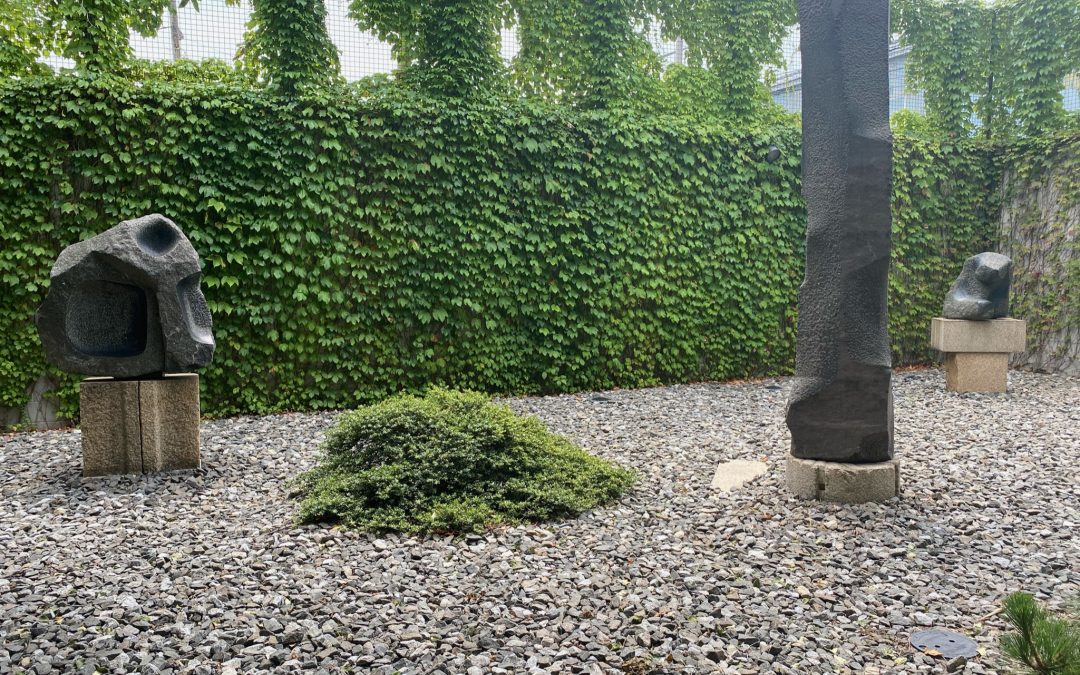In 1985, sculptor and landscape architect Isamu Noguchi opened a museum of his work in an industrial building in Long Island City, New York. It’s a place to go for a zen experience, especially after all the stressors that continue to rip our world apart. Reservations are limited, but if you can buy the $10 ticket ahead of time, it’s only a short trip from Manhattan, close to LaGuardia Airport.
In art, I look for a way to make sense out of life, to find beauty or joy, and hopefully find a place of rest. Noguchi does the latter for me, which is especially needed during difficult times. Though Noguchi used art to protest nuclear war and destruction, his work brings us to a place where we put rhetoric to rest, unlike activist artists of today who scream with anger and miss the mark of meaningful communication.

Noguchi is first and foremost a landscape architect, but also a furniture designer and sculptor. It’s not surprising that he studied with Brancusi. They were similar souls. A current exhibition at the museum is called Useless Architecture. But what is “useless architecture” is “useful sculpture.”
Many of his sculptures are upright, rough and irregular. They remind me of the monumental stones of ancient Britain and Europe, called menhirs. Like the menhirs, they’re raw assertions of strength with the overlay of a human imprint.

But other sculptures — especially End Piece — are like the dolmens of ancient Europe, formed when the upright stones hold horizontal stones. According to Britannica, “Dolmens represented the first real attempt by the settlers to organize and shape the landscape around them.“ It also combines many oppositions: wood and stone, rough and/or polished, linear or curved, straight or angled, vertical and horizontal. When you ponder it, these contrasts reflect the oppositions that make up life, oppositions that need to be brought into harmony.

We absorb Noguchi and the meanings of his works through silence. They’re imperfect, but feel “right.” Though Noguchi’s sculpture is architectural, it is not architecture.
Noguchi’s body of work replicates how mankind fits into nature — but readjusts it for a comfortable fit. The best of artists are able to teach us how to see, both the inner and outer worlds, and to bridge our gaps of understanding. One sculpture of a steel-cut trapezoid with a suspended rock in the center says it all. The museum sent me the name of the piece, Costume for a Stone. The combination of natural and manmade materials, common to so much of Noguchi’s work, works beautifully here.

Circles repeats a theme Noguchi sculpted over and over again. An upright pink granite circle is called Sun at Noon; nearby is a black circle called Midnight. Circles have no beginning or end; they’re the Alpha and the Omega, the symbol of God, a representation of perfection.

There’s another pink sculpture nearby that resembles a snake. Noguchi called it Magic Ring, I’m reminded that life is a journey, The journey is not predictable, but it can take you to places of magic.

Noguchi said, “If sculpture is the rock, it is also the space between the rocks, and between the rock and a man.”
I was curious about a piece called Sentinel. Noguchi made the stainless steel sculpture specifically for an exhibition at the Pace Gallery in 1975. The name suggests that it is standing guard somewhere. All parts of it to fit into the proper place: the horizontals, the verticals and two circles.

Noguchi knew humanity’s place in the natural order of the things, which is one reason why he was so horrified with the prospect of atomic destruction, a subject that is on exhibition on the 2nd floor of the museum now. There’s a model for a monument to the victims of Hiroshima, a project that was never built. It would have been a magnificent arch set off in a symmetric line, with the victims’ names underground. Most of Noguchi’s own life was split between the US and Japan,
His father was Japanese poet, his mother an American writer. He was born in Los Angeles, in 1904, but raised primarily in Japan. His spent his life between the two countries. Then when the US was at war with Japan, he voluntarily interred himself in Arizona. I have written previously of his sculpture in Smithsonian Collections.
Why should we go to this museum? — to make peace with the most impossible of situations. “Due to war, Noguchi also knew the pain of belonging to nations that were bitter enemies, and he produced artworks imbued with an earnest desire for peace,” according to the Noguchi Museum website. He is an artist who moves me to another frame of mind.

Noguchi bought an old photogravure studio and designed the building to accommodate his museum. It was across the street from his studio.


Inspiring. Thanks for posting.